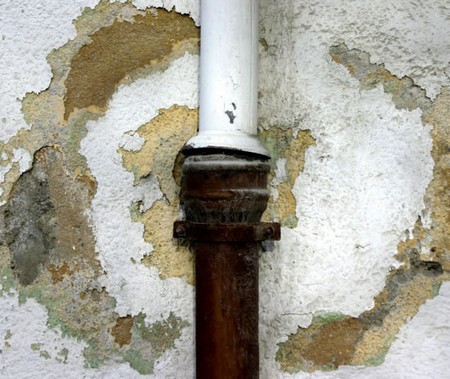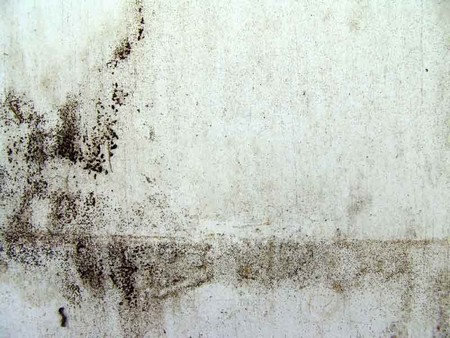Before you take any remedial action against penetrating damp, you should make sure that the cause of dampness is indeed water penetration and not condensation or rising damp.
Generally, penetrating damp is easier to diagnose when you have cavity walls than when you have solid walls. With cavity walls, visible dampness can be more obviously correlated with rainfall, and drying out afterwards is likely to be more rapid. With solid walls, the greater thickness of masonry tends to smooth out fluctuations with the weather and leads to more diffuse damp patches which can be confused with condensation. It helps if you look for these during heavy driving rain so that you can sec whether water is being directed on to those walls with a dampness problem. Take this opportunity to look at the areas around doors and windows too.

To confirm a rain penetration problem, trickle water on the outer leaf of the affected wall across an area about two metres wide and about two or three metres above the position of visible dampness in your house. If the damp patch grows or becomes more distinctly visible within about an hour, penetrating damp is the likely problem.
Occasionally, penetrating damp is caused by leaks in water supply pipes buried in the wall or passing along the cavity. Obviously, in these cases the appearance of damp patches is not correlated with rainfall.
Damp near windows and doors
Rain often penetrates around openings in external walls, such as windows and doors. Unfortunately, the precise cause of the problem can be rather elusive.
First, make sure that visible seals between the frame and wall are intact – they may have been made with a hard-setting material which has deteriorated with age. Small cracks can be blocked with an external wall filler and then primed and painted over; with large cracks the joint should be raked back and then refilled. Non-setting mastic sealants are best for this purpose. With windows, you should make sure that the drip channel in the sill is not blocked by dirt or successive layers of paint. If the problem persists, further examination is necessary.
In solid walls, water may penetrate the brickwork around the frame – for example, in a prevailing cross-wind, driving rain may be concentrated on the jamb to one side of the window. A damp problem in this area can be solved by repointing the brickwork followed by local treatment with a surface water repellent.
In cavity walls, penetration around door and window openings is usually due to faulty installation of the damp-proof course. Often dampness over an opening is due to an accumulation of mortar droppings on the lintel DPC which were allowed to fall down during construction of the brickwork above. The mortar may stop the damp-proof course operating correctly and allow water to cross the cavity.
Water penetration at the side of an opening may arise from a badly installed vertical DPC at the cavity closure. Alternatively, the lintel DPC may be incorrectly installed such that it sheds its water too near the window openings – for example, the DPC may not extend sufficiently far beyond the end of the lintel into the cavity.
Penetration at the bottom corners of windows is sometimes due to mortar lodged on the part of the sill which projects into the cavity.
Putting these faults right can be difficult and usually involves removing some brickwork so that you can see what the problem is. Cleaning away simple mortar obstructions is relatively straightforward, but for more complex tasks – such as altering or installing a DPC – you may want to call in a builder.

Damp patches on walls
When damp patches occur on cavity walls well away from door and window openings, the probable causes are splashing or cavity bridges. If there are only one or two areas of dampness, it is worth taking out some of the bricks from the outer leaf so that you can see into the cavity. Provided the mortar is in reasonable condition, you can remove several bricks in a single horizontal run without affecting the structural stability of the wall – but do not overdo it.
To remove the bricks, drill closely spaced holes in the mortar joints around one brick using a masonry drill, then gently hack away at the remaining mortar with a flat chisel. Carefully remove the bricks in one piece so that they can be replaced later. Make sure that no large pieces of mortar or brick break off and fall into the cavity – these could act as a cavity bridge at some later date.
By using a mirror and torch, you should be able to see for a considerable distance inside the inspection hole – use the mirror for reflecting torchlight into the cavity at the same time as for viewing. Sometimes, when you remove the bricks you dislodge the bridge. Inspection of the inner leaf will often reveal whether this was so – for example, you may see staining or a fresh surface on mortar stuck to the inner leaf. A good vantage point for inspection is an outside corner of the house. Bricks removed here give a good view along the cavity without the need for a mirror.
If the dampness is due to a simple mortar or brick obstruction in the cavity, you should be able to dislodge it with a rigid pole or stiff piece of wire. Make sure that any obstruction falls to the foot of the wall, below the DPC.